Rapport

This article is part of Bain’s 2019 Global Private Equity Report. This section looks at how the biggest firms are beating corporate competitors at their own game by executing large-scale strategic mergers. Explore the contents of the report here or download the PDF to read the full report.
If deals like LifePoint Health’s $5.6 billion merger with RCCH HealthCare Partners or RCN’s $2.4 billion takeover of Wave Broadband look and feel like straight-ahead corporate M&A transactions, then … mission accomplished. For Apollo and TPG, the owners of LifePoint and RCN, respectively, executing corporate-style M&A was all part of the plan.
PE funds are increasingly turning to large-scale M&A to solve what has become one of the industry’s most intractable problems—record amounts of money to spend and too few targets. GPs have put more money to work over the past five years than during any five-year period in the buyout industry’s history. Still, dry powder, or uncalled capital, has soared 64% over the same period, setting new records annually and ramping up pressure on PE firms to accelerate the pace of dealmaking. One reason for the imbalance is hardly a bad problem: Beginning in 2014, enthusiastic investors have flooded buyout funds with more than $1 trillion in fresh capital. Another issue, however, poses a significant conundrum: PE firms are too often having to withdraw from auctions amid fierce competition from strategic corporate buyers, many of which have a decided advantage in bidding.
Given that large and megabuyout funds of $1.5 billion or more hold two-thirds of the uncalled capital, chipping away at the mountain of dry powder will require more and bigger deals by the industry’s largest players (see Figure 2.6). Very large public-to-private transactions are on the rise for precisely this reason. But increasingly, large funds are looking to win M&A deals by recreating the economics that corporate buyers enjoy. This involves using a platform company to hunt for large-scale merger partners that add strategic value through scale, scope or both.
Megafunds hold by far the largest share of dry powder, dialing up the pressure to do more multibillion-dollar deals

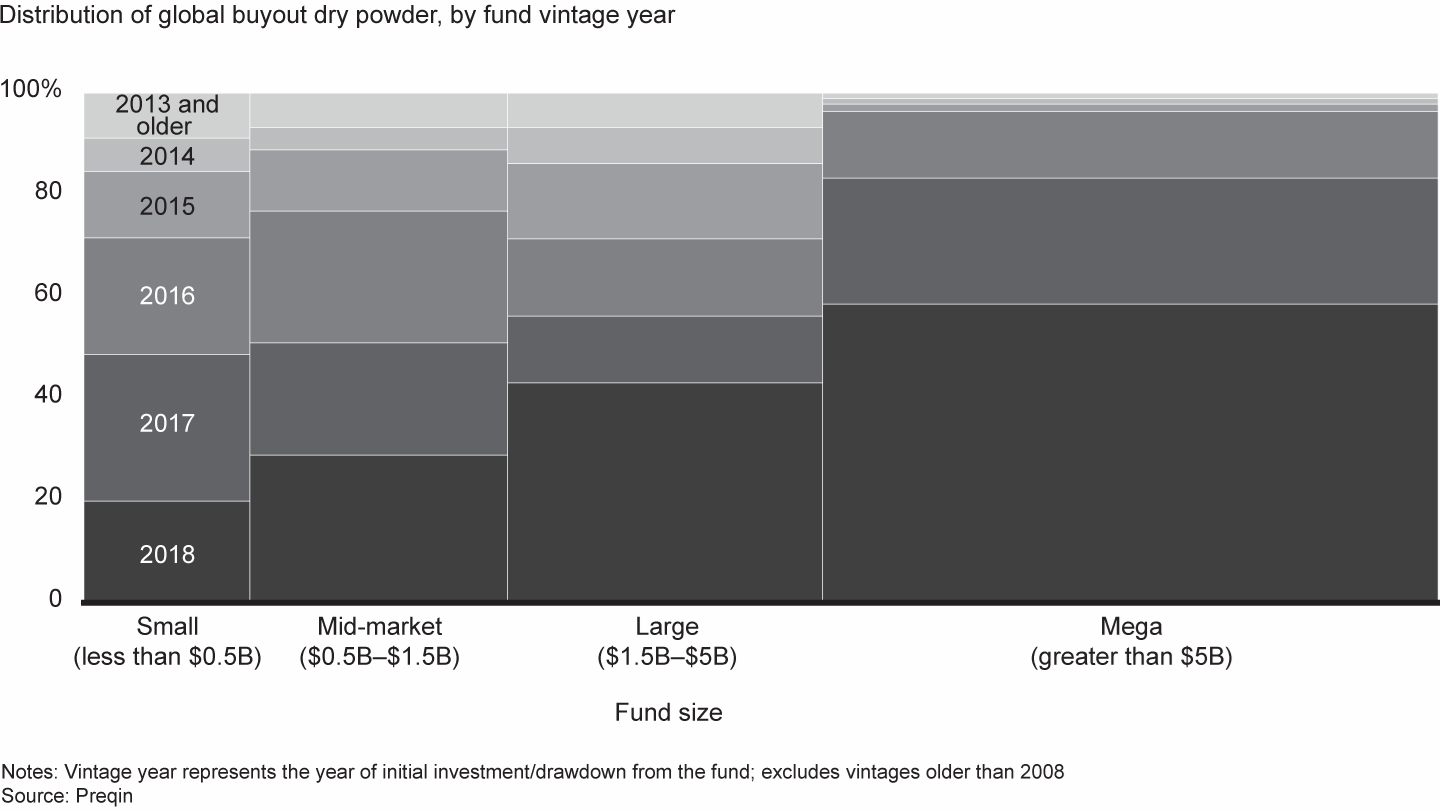
Apollo saw the opportunity last year to take its 2015 acquisition of RCCH to another level by merging it with LifePoint Health. The firm bought LifePoint for $5.6 billion in July and then combined the two companies to create a much larger player in the healthcare industry. The merger produced a national operator of 84 nonurban hospitals in 30 states, with 7,000 affiliated physicians and approximately 60,000 employees. The strategic imperative is to improve the economics of providing local hospital care in less populous areas, while generating new opportunities for growth and partnerships as the healthcare industry evolves.
Making it all work, of course, is another matter. Large-scale, strategic M&A solves one problem for large PE firms by putting a lot of capital to work at once, but it also creates a major challenge: capturing value by integrating two or more complex organizations into a bigger one that makes strategic and operational sense. Bain research shows that, while there is clear value in making acquisitions large enough to have material impact on the acquirer, the success rate is uneven and correlates closely to buyer experience (see Figure 2.7). The winners do this sort of deal relatively frequently and turn large-scale M&A into a repeatable model. The laggards make infrequent big bets, often in an attempt to swing for the fences strategically.
Merger integration experience pays off in rapid growth and strong shareholder returns

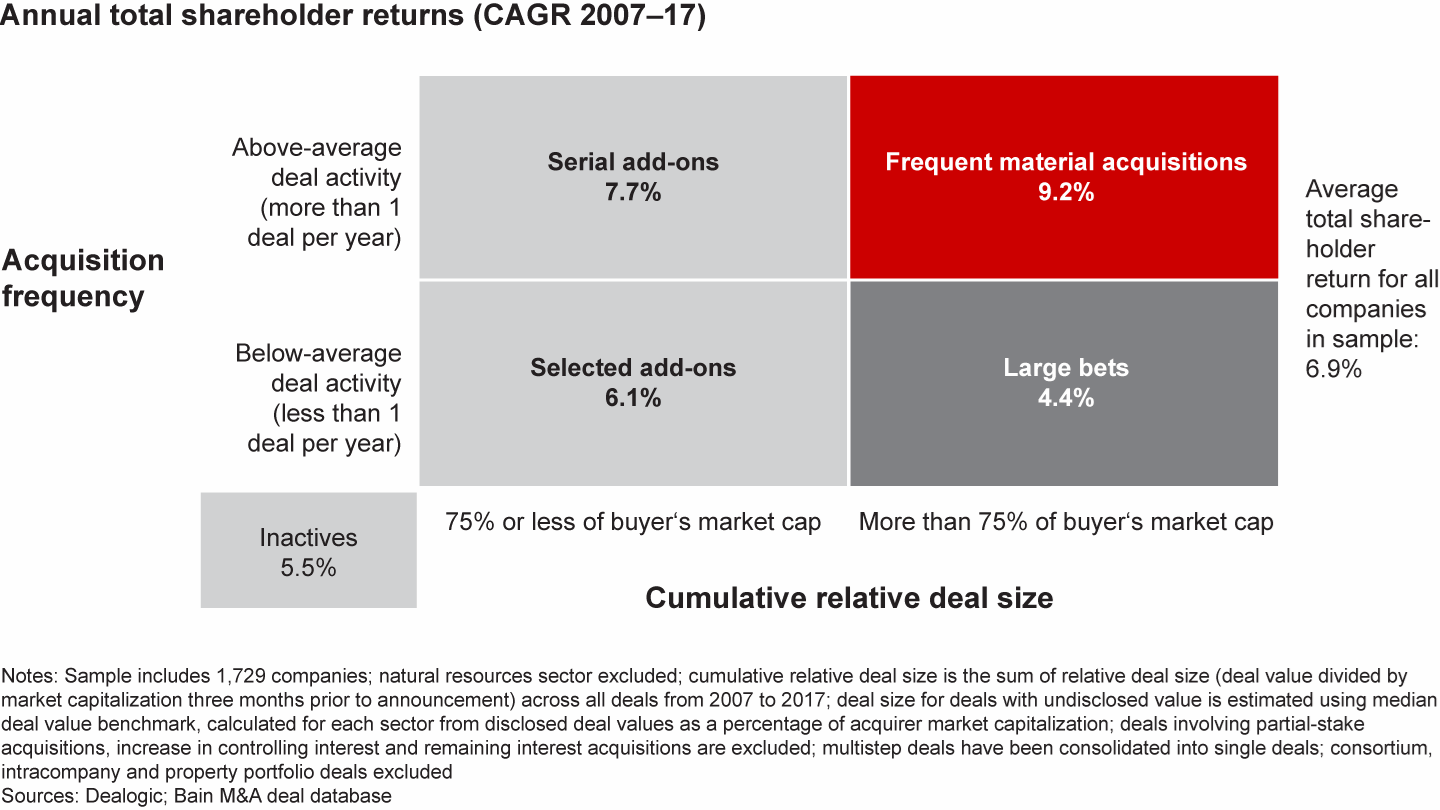
Broken deals tend to fail because firms stumble over merger integration. They enter the deal without an integration thesis or try to do everything at once. They don’t identify synergies with any precision, or fail to capture the ones they have identified. GPs neglect to sort out leadership issues soon enough, or they underestimate the challenge of merging systems and processes. For many firms, large-scale merger integration presents a steep learning curve.
In our experience, success in a PE context requires a different way of approaching three key phases of the value-creation cycle: due diligence, the post-announcement period and the post-close integration period (see Figure 2.8). In many ways, what happens before the deal closes is almost as important as what happens after a firm assumes ownership. Top firms invest in deep thinking about integration from the outset of due diligence. And they bring a sharp focus to how the firm can move quickly and decisively during the holding period to maximize time to value.
Successful merger integration begins with strong due diligence and stretches well into the ownership period

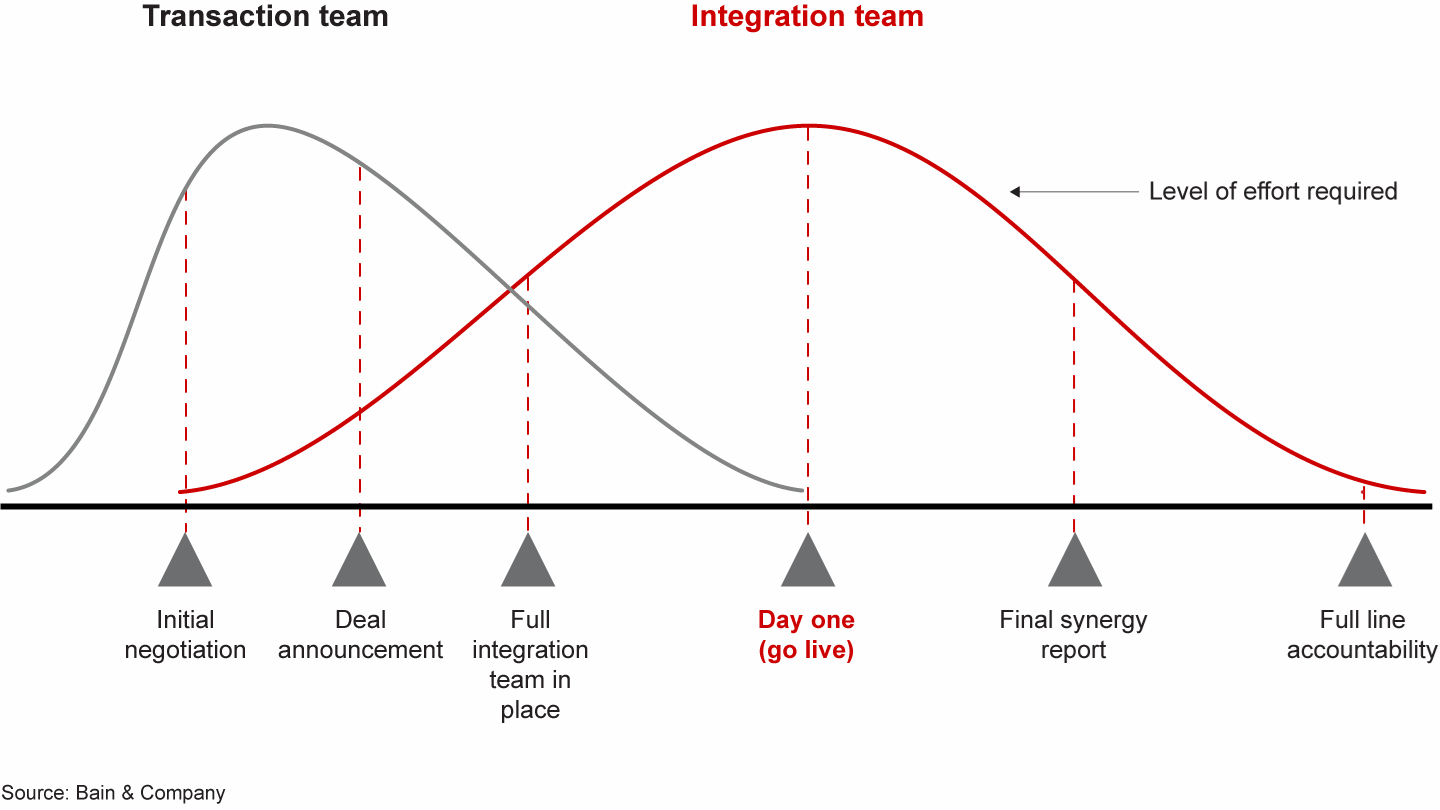
Due diligence: Building a foundation
In a standalone due diligence process, deal teams focus on a target’s market potential, its competitiveness, and opportunities to cut costs or improve performance. In a merger situation, those things still matter, but since the firm’s portfolio company should have a good understanding of the market already, the diligence imperative switches to a bottom-up assessment of the potential synergies.
Measuring synergies. Synergies typically represent most of a merger deal’s value, so precision in underwriting them is critical. High-level benchmarks aren’t sufficient; strong diligence demands rigorous quantification. The firm has to decide which synergies are most important, how much value they represent and how likely they are to be captured within the deal’s time frame. When Blackstone’s Graham Packaging acquired Liquid Container for $568 million in 2010, for instance, the deal had elements of both scale and scope. Liquid Container, which specialized in food-grade blow-molded plastic containers, offered Graham the chance to expand for the first time into the high-margin food segment. The deal also promised to add scale in Graham’s household container business. Diligence uncovered $25 million in cost synergies from sharing the procurement of plastic resin, rationalizing the manufacturing footprint and eliminating duplicative G&A expenses. Blackstone identified significant revenue synergies as well.
A full understanding of the synergies available in a deal like this allows a firm to bid as aggressively as possible. It often gives the deal team the option to share the value of synergies with the seller in the form of a higher acquisition price. On the other hand, the team also needs to account for dis-synergies—the kinds of negative outcomes that can easily lead to value destruction. When AEA Investors merged TimberTech with CPG International, for instance, it saw a chance to generate savings by consolidating the two companies’ manufacturing footprints and reducing capacity. But such a move would also generate new costs—standing up new production lines, moving down the new production learning curve, closing existing facilities and so on. Netted out, the synergies still produced substantial savings. But in formulating a bid, it was critical for AEA to anticipate both the positive and negative implications.
Tapping the balance sheet. One area of potential synergies often underappreciated by corporate buyers is the balance sheet. Because companies in the same industry frequently share suppliers and customers, combining them presents opportunities to negotiate better contracts and improve working capital. There might also be a chance to reduce inventory costs by pooling inventory, consolidating warehouses or rationalizing distribution centers. At many target companies, these opportunities represent low-hanging fruit, especially at corporate spin-offs, since parent companies rarely manage the working capital of individual units aggressively. Combined businesses can also trim capital expenditures. Merging the operations of Graham Packaging and Liquid Container, for example, made it possible for the combined company to cut back on procured molds and spare machinery parts.
Managing the “soft” stuff. While these balance sheet issues play to a GP’s strong suit, people and culture issues usually don’t. PE firms aren’t known for their skill in diagnosing culture conflicts, retaining talent or working through the inevitable HR crises raised by integration. Firms often view these so-called soft issues as secondary to the things they can really measure. Yet people problems can quickly undermine synergies and other sources of value, not to mention overall performance of the combined company.
To avoid these problems, it helps to focus on two things in due diligence. First, which of the target company’s core capabilities need to be preserved, and what will it take to retain the top 10 people who deliver them? Second, does the existing leadership team—on either side of the transaction—understand how to integrate a business? The firm needs to know whether those responsible for leading the integration have done it before, whether they’ve been successful and whether the firm can trust them to do it successfully in this situation. PE owners are often more involved in integration than the board of a typical corporation. It’s important not to overstep, however. Bigfooting the management team is a sure way to spur a talent exodus.
For PE firms eager to put money to work, great diligence in a merger context is critical. It should not only answer questions such as “How much value can we underwrite?” but also evaluate whether to do the deal at all. Deal teams have to resist the urge to make an acquisition simply because the clock is ticking. Corporate buyers often take years to identify and court the right target. While it’s true that PE firms rarely have that luxury, no amount of merger integration prowess can make up for acquiring a company that just doesn’t fit.
Key questions: Due diligence
- What is our bottom-up estimate of cost, cash and revenue synergies, accounting for potential dis-synergies? Which are we willing to underwrite and share with the seller?
- How long will the integration take? How quickly will value be realized?
- How efficient is each of the organizations today? Is there room for improvement?
- Does the acquiring company have a good “chassis”—that is, scalable IT systems and sound infrastructure—for adding on new assets? If not, what investment is required to get there?
- Have we identified the combined firm’s critical capabilities and the key individuals who deliver them? Do we have a plan to retain them?
- Do we understand the cultures of the two companies and how potential discord might affect time to value?
- Has the leadership team successfully managed a merger in the past? How much help will they need?
- Have we negotiated some level of pre-close access to the acquired company’s systems and management team?
- What else is going on in these companies—previous merger integrations, cost initiatives, new business plans—that will consume management attention? Do they have enough bandwidth to manage a complex integration?
Mobilizing the integration
Even the best due diligence is limited by the fact that it is largely an outside-in process. That begins to change once an offer is accepted. The period between deal announcement and close is vital to filling in knowledge gaps and turning a deal thesis into a formal plan for integrating the two organizations. It starts with creating a shared vision for the combined company and beginning to communicate it to the companies’ various stakeholders. The buyer has to map out which parts of the organization should be integrated to unlock scale economics and which parts should be kept separate to preserve differentiated capabilities. The integration thesis should set priorities, lay out implementation steps and estimate how long it will take to capture value. One of the most important steps GPs can take during the pre-close period is to sort out governance issues for the merged entities. Who reports to whom in the interim, and what activities is each side responsible for? After clinking glasses at the merger announcement party, the two management teams staring at each other across the room need to know who will be running things and what their roles are ahead of the deal close.
Light touch or heavy touch? When Graham Packaging began thinking through the best way to bring Liquid Container into the fold, it became clear early on that integrating strategically would add the most value. As we noted earlier, the deal offered substantial cost synergies from combining procurement and rationalizing aspects of production. The merger’s true promise, however, involved scope—giving Graham access to a lucrative new market that was growing. Liquid Container’s food-grade blow-molded containers had little customer or market crossover with Graham. The company had developed market-leading technology to serve these sectors and had a strong portfolio of patents pending. If Graham could manage the integration, it would increase both its scale and scope.
A key to success was retaining Liquid Container’s top talent. Blackstone and Graham Packaging were confident that Graham could capture the synergies between the two companies, but Graham needed to rely on Liquid Container’s management team to make the most of the opportunity. Graham decided to operate Liquid Container as a freestanding unit and made it abundantly clear to the people it wanted to retain that they would be free to run their own show, subject to the new strategic plan. The integration was by no means easy. To capture the synergies and work through the hundreds of issues any merger raises, Graham formed a steering committee led by the CEO, which managed 13 integration teams charged with finding cost savings and rationalizing the business where it did intersect. But Graham’s light touch with the Liquid Container team was central to the deal’s success.
Setting up an IMO. The sheer complexity of integrating any two large organizations frequently calls for a dedicated integration management office (IMO). There’s usually no other way to manage the daily barrage of complicated, high-stakes decisions. Integration planning demands rapid, cross-functional decision making among stakeholders who haven’t worked together before. There are countless interdependencies and issues that require continuous prioritization. An IMO run by smart, dynamic executives serves as an air traffic control tower—anticipating risks, mitigating them and making real-time decisions. The office focuses teams on the most important elements of value and develops tools to measure progress.
Managing communications is an often-overlooked priority. Companies are limited in what they can say during the pre-close period, but it is critical to get the story straight and issue consistent messages from both companies. Leadership needs to reach out to stakeholders and let them know when more information will be available. Indeed, a major element of integration preplanning is forging the mission statements and day-one communiqués that will ensure business continuity and project decisiveness once the new owner takes control.
Enlisting a “clean team.” No matter how close the two companies have become through the courtship period and deal negotiations, there is always certain information, contracts and data that the seller must withhold from the buyer in case the deal falls apart. One way around that is to set up a clean team—a third party that can begin the time-consuming work of sorting through proprietary information. This protects each company’s confidentiality but allows them to get a jump on validating synergies prior to close.
Setting up a clean team isn’t simple. There has to be significant value at stake and time to implement one. But in a PE context, where speed to value is paramount, it can be a highly effective tool. Being able to capture, codify and analyze proprietary information pre-close can save a firm valuable time later.
Key questions: Mobilizing the integration
- Have we effectively translated the deal thesis into a comprehensive integration thesis?
- Have we established an integration structure and team aligned to the integration thesis, headed by an effective integration leader?
- Have we defined the right operating model and governance scheme for the merged company, and do we know who reports to whom in the short term?
- Is there a plan to communicate the value created in this deal and what the future holds for employees, customers and sourcing partners?
- Do we need a clean team to help capture the value at stake quickly?
- Have we established an overall integration timeline, including what’s “in scope” for day one?

Get Our Latest Private Equity Insights
Receive Bain’s landmark Global Private Equity Report each February, plus the latest insights and developments in private equity throughout the year.
Integration planning and execution
Once the hard work of underwriting value and generating a robust integration thesis is complete, integration planning begins in earnest. A successful integration has three major objectives: capturing the identified value, managing the people issues, and integrating processes and systems (see Figure 2.9). This is where the IMO needs to shine. As the central leadership office, its role is to keep the integration effort on track and to hit the ground running on day one. Pre- and post-close, the IMO monitors risks (including interdependences), tracks and reports on team progress, resolves conflicts, and works to achieve a consistent drumbeat of decisions and outcomes. It manages dozens of integration teams, each with its own detailed work plan, key performance indicators and milestones. It also communicates effectively to all stakeholders.
Generating results from a comprehensive integration thesis requires sharp execution to capture value, align people and install systems

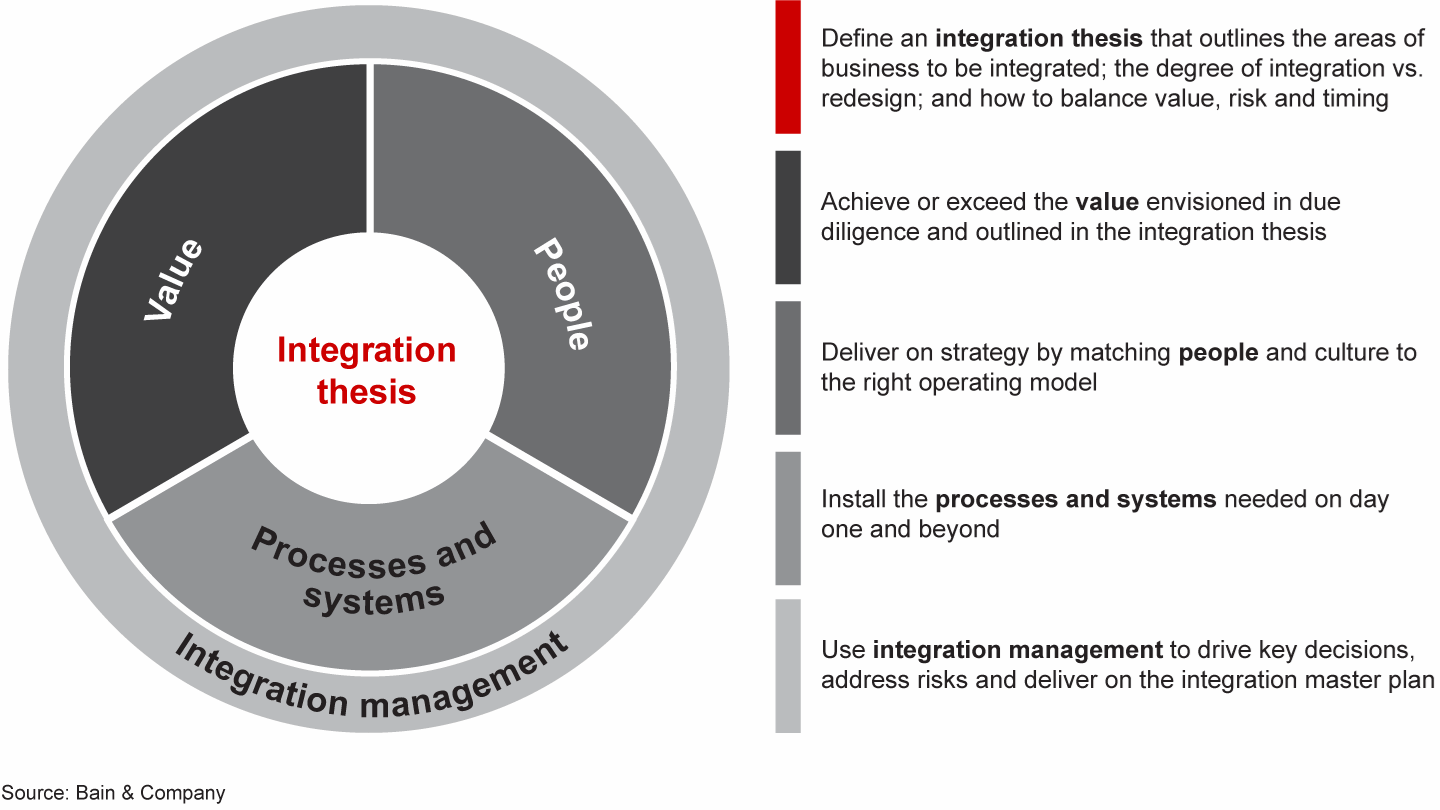
Cinven and Warburg Pincus took on the full scope of this integration management challenge when, in 2005–06, they bought three Dutch cable providers to create Ziggo, the largest cable operator in the Netherlands. The combination was purely a scale play, a three-way merger of equal-sized rivals with complementary strengths. It offered more than €100 million in synergies (around 20% of the cost base) related to operating expenses, cost of goods and capital expenditures. Capturing that value, however, meant rapidly transforming three disparate companies into a single organization with a unified brand, technology platform and go-to-market strategy. The complex deal offered a significant opportunity to combine the best practices developed at each firm, creating a leading “cable operator of the future” that could entice customers with a triple-play bundle of cable, high-speed Internet and telephone. It helped that the deal was a true merger of equals. And it helped the integration effort that there was no dominant acquirer. Each of the three management teams had equal representation and an equal say in decisions.
Cinven and Warburg Pincus formed a centralized IMO led by a single strong executive and a deputy. These two executives were 100% dedicated to the integration effort and quickly laid out a detailed plan to stand up the new company. They deployed 35 integration teams and a set of task forces to tackle specific initiatives. That focused energy on everything from building a new data warehouse and creating a single service-platform architecture, to optimizing the business model and developing a new brand for the consolidated company. The results were impressive. The combined company exceeded its synergy targets, while producing strong growth in revenue and EBITDA over the three years following the merger. Cinven and Warburg Pincus exited the public company in tranches, realizing a 2.8 times return on invested capital.
Capturing value. An often-underappreciated aspect of the early merger integration process is the art of maintaining continuity in the base business. Knitting together the two organizations and realizing synergies is essential, but value can be lost quickly if a chaotic integration process gets in the way of running the core. Management needs to reserve focus for day-to-day operations, keeping close tabs on customers and vendors, and intervening quickly if problems crop up.
At the same time, it is important to validate and resize the value-creation initiatives and synergies identified in diligence. The team has to create a new value roadmap that articulates in detail the value available and how to capture it. This document redefines the size of the prize based on real data. It should be cascaded down through the organization to inform detailed team-level work plans.
Tackling the people challenge. Integrating large groups of people is very often the most challenging—and overlooked—aspect of bringing two companies together. Mergers are emotionally charged events that take employees out of their comfort zone. While top leadership may be thinking about pulling the team together to find value, the people on the ground, understandably, are focused on what it means for them. The change disrupts everybody; nobody knows what’s coming, and human nature being what it is, people often shut down. Getting ahead of potential disaster involves three critical areas of focus: retaining key talent, devising a clear operating model and solving any culture issues.
Talent retention boils down to identifying who creates the most value at the company and understanding what motivates them. Firms need to isolate the top 50 to 100 individuals most responsible for the combined company’s value and devise a retention plan tailored to each one. Keeping these people on board will likely involve financial incentives, but it may be more important to present these stars with a clear vision for the future and how they can bring it to life by excelling in mission-critical roles. It is also essential to be decisive and fair in making talent decisions (see Figure 2.10).
PE firms need to be decisive and fair in selecting and retaining talent

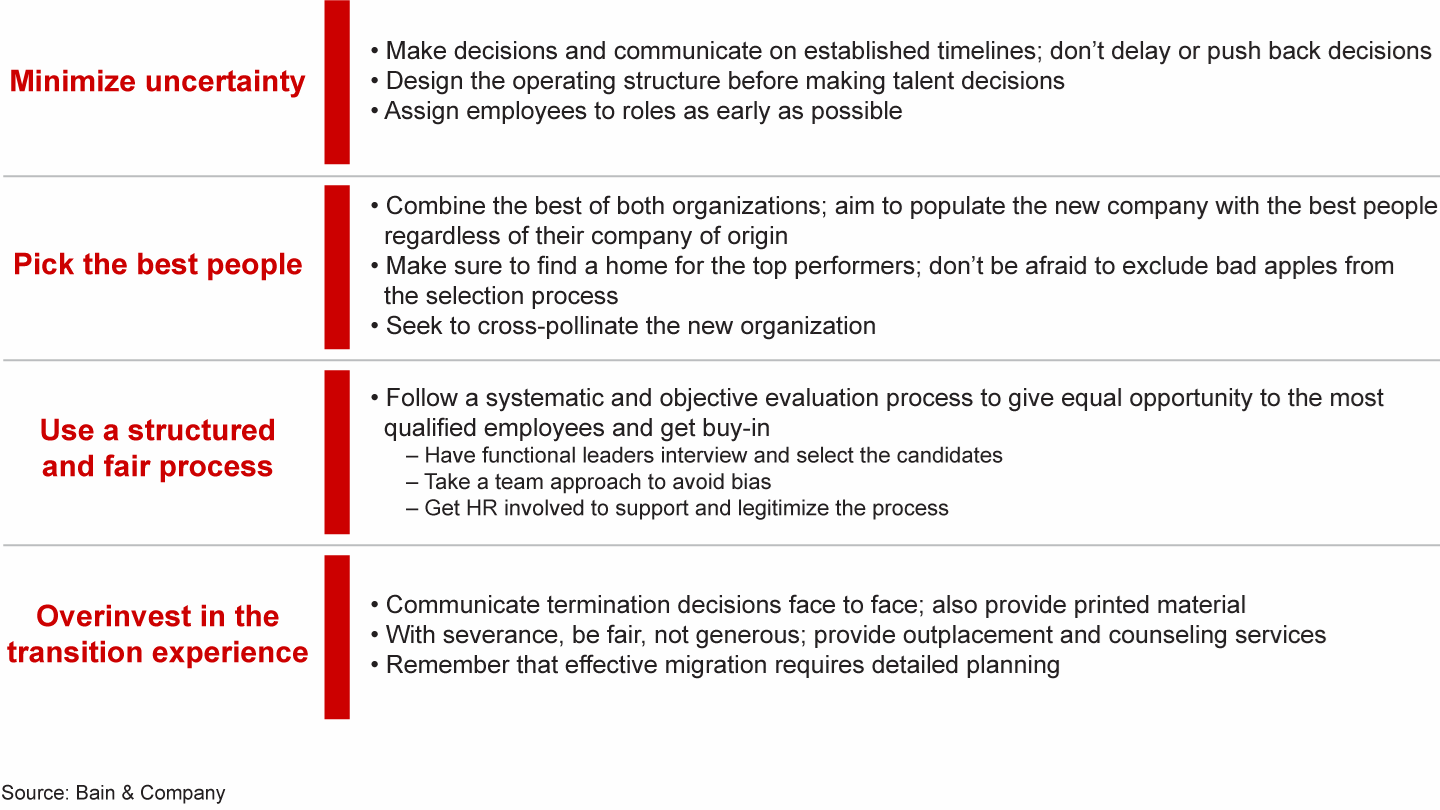
Assigning these roles is an outgrowth of a larger challenge: devising a fit-for-purpose operating model that aligns with the overall vision for the company. This is the set of organizational elements that helps translate business strategy into action. It defines roles, reporting relationships and decision rights, as well as accountabilities.
Whether this new model works will have a lot to do with how well leadership manages the cultural integration challenge. Nothing can destroy value faster than internal dysfunction, but getting it right can be a delicate exercise. When AEA was merging CPG and TimberTech, for instance, it recognized that TimberTech had a distinct position in the marketplace that partly reflected its unique company culture. TimberTech maintained strong personal relationships with its channel partners and had a reputation for warm and fuzzy customer service. In thinking about how to integrate the two companies, CPG saw value in preserving that culture and the TimberTech brand vs. trying to integrate everything rapidly at the risk of customer attrition or talent loss.
Processes and systems. The final integration imperative—designing and implementing the new company’s processes and systems—is all about anticipating how things will get done in the new company and building the right infrastructure to support that activity. PE firms must consider which processes to integrate and which to leave alone. The north star on these decisions is which efforts will directly accrue to value within the deal time frame and which can wait. Often, this means designing an interim and an end-state solution, ensuring delivery of critical functionality now while laying the foundation for the optimal long-term solution.
Integrating IT systems requires a similar decision-making process, focused on what will create the most value. If capturing synergies in the finance department involves cutting headcount within several financial planning and analysis teams, that might only happen when they are on a single system. Likewise, if the optimal operating model calls for a fully integrated sales and marketing team, then working from a single CRM system makes sense. Most PE firms are hyperfocused on the expense involved in these sorts of decisions. They weigh the onetime costs of integration against a sometimes-vague potential return and ultimately decide not to push forward. This may be a mistake. Taking a more expansive view of potential value often pays off. Early investments in IT, for instance, may look expensive in the short run. But to the extent that they make possible future investments in better capabilities or continued acquisitions, they can be invaluable.
Key questions: Integration planning and execution
- Now that we have all of the data, what did we get right in the diligence phase, and what did we miss?
- Do we have a credible plan (and the needed resources) to achieve the synergies we’ve identified?
- What are the risks and downsides to achieving these synergies, and how do we manage them?
- Who are the influencers, critical contributors and integration enablers in the new organization, and how do we retain them?
- Where are the interdependencies between people, systems or processes, and how are we managing them?
- What did we learn through the creation of this new company, and how should that inform the future strategy?
There’s a reason so many large mergers go awry—successfully combining large, complex organizations is exceptionally hard to do. It is even more difficult in the PE context, thanks to shortened time frames and most firms’ relative inexperience in many aspects of merger integration. The firms that do it right raise the odds of success by identifying as much value as possible in due diligence, translating that work into a detailed integration thesis and being fully prepared to implement it methodically once the deal is closed (see Figure 2.11). PE firms are finding there’s money to be made in beating corporate competitors at their own game. They’re also discovering that it’s a lot harder than it looks.
Successful mergers follow a methodical path from integration thesis to integration management

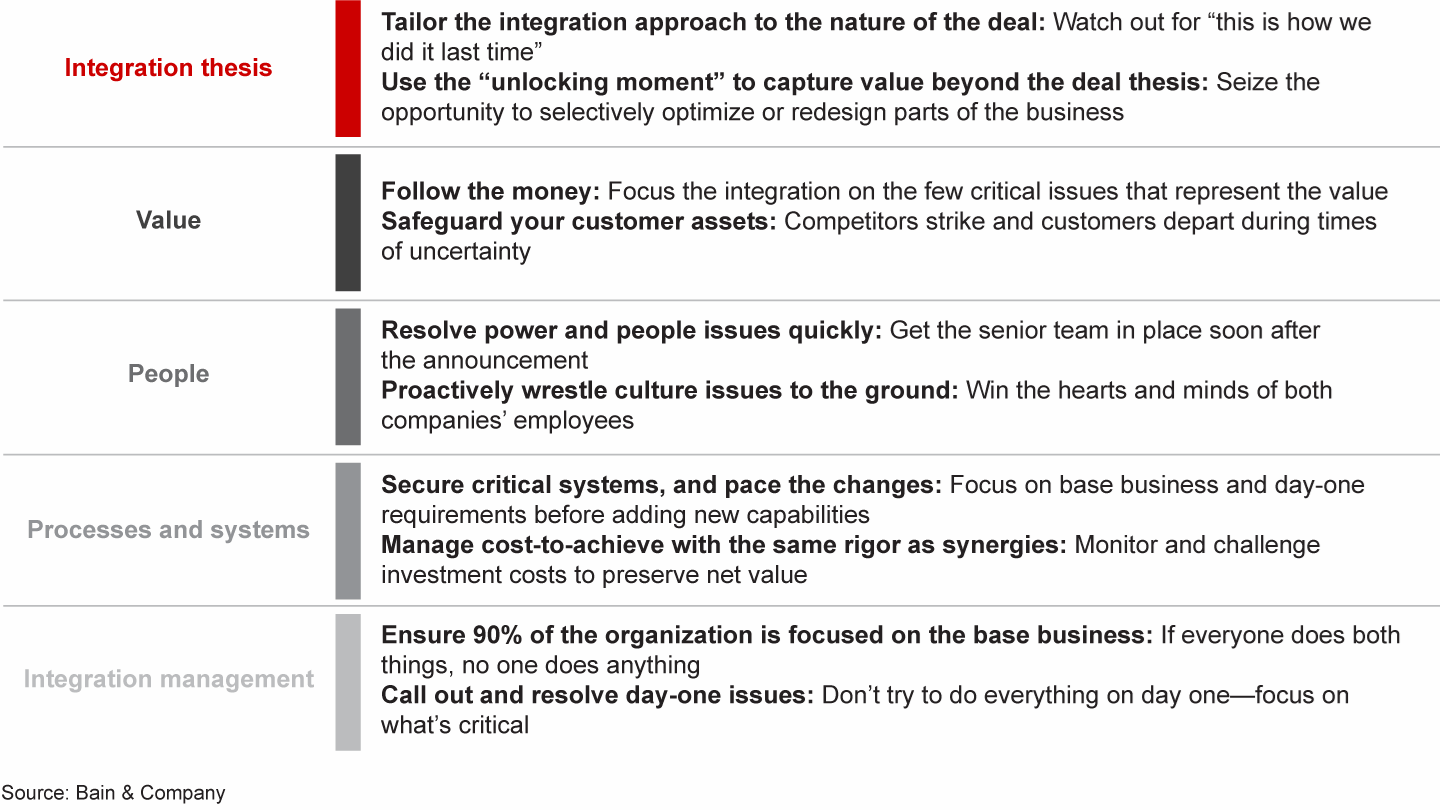
This article is part of Bain’s 2019 Global Private Equity Report. Explore the contents of the report here or download the PDF to read the full report.